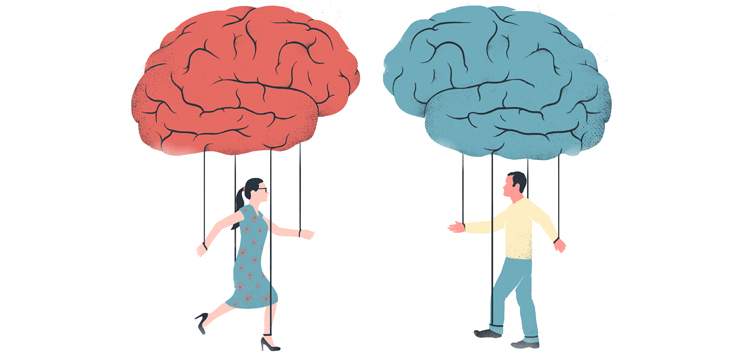Most of us think women’s brains are geared for empathy while men’s brains play dead when they have to interpret and process emotions. But the truth is, in fact, quite a bit messier—despite what some of the research claims.
The ability to feel what others feel and intuit their emotions from their body language, tone of voice, and other indirect clues is not only something that women are supposedly better at than men, but one that reflects (some researchers contend) hardwired sex-based differences in the brain. Among the cadre of scientists who study this, the empathy gap is considered strong evidence for “the essential difference” between female and male brains, namely, that female brains are good at sympathizing and male brains at using logical thinking to classify and analyze the world.
Here’s the first mess: measures of empathy are as hard to pin down as a puddle of mercury. When questions are obviously about empathy (can you easily tell if someone is unhappy but putting on a brave face?), women score themselves much higher than men do. But when researchers ditch self-report questionnaires and put subjects in situations that actually test their empathizing and logic abilities, men and women score about equally
Why the different results from different experimental set-ups?Psychology researcher Cordelia Fine of the University of Melbourne suggests that because we’re all steeped in society’s image of our sex, a well-established phenomenon called “stereotype threat” kicks in: When reminded of stereotypes about our sex, race, or nationality, we generally conform to them. (Women asked to think about their gender—“girls can’t do math”—before a math test, for instance, do worse than otherwise.) That may be happening with measures of empathizing: when women are reminded that their sex is reputed to be empathic, and men that they’re emotional clods, both sexes are unconsciously motivated to say they meet that expectation.
Motivation, too, has a bigger effect on many abilities than sex. When men were told that women are sexually attracted to men who are in touch with their feminine side, they scored higher on empathic accuracy than men who weren’t fed that line, found a 2008 study in the Journal of Personality and Social Psychology. When asked how much they sympathize with people in distress, before a test of reading others’ emotions, men did much worse than women, perhaps because the question reminded them that real men don’t empathize. But scrub the sympathy question and instead offer $2 for correct answers, and the sexes performed equally. “When it literally pays to understand,” as Fine put it in her wonderful 2010 book Delusions of Gender, “male insensitivity is curiously easily overcome.”
One of my favorite examples of how our emotional abilities can be encouraged or smothered involves how well people can work out others’ relationships from their interactions. When it’s described as a test of social skills, men do somewhat worse than women. When it’s described as a test of “complex information processing,” men do better. This stereotype effect extends to cognitive areas, too. Numerous studies have reported that men are better than women at mental rotation, or manipulating images in their heads. When researchers described mental rotation as linked to success in aviation engineering and nuclear propulsion engineering, men trounced women. When they described it as linked to dress design and needlepointing, men’s performance plummeted and women’s rose.
Supposedly sex-based talents like empathy and manipulating images in our heads are as changeable as the moon. It depends on how you frame the question.
The fact that supposedly sex-based talents like empathy and mental rotation are as changeable as the moon has implications for studies of brain signatures underlying emotional and cognitive skills. Since changing things like group membership can change performance, “this implies that the neural correlates will be contingent, too,” Fine told me. “In other words, you have not necessarily found ‘the’ sex difference in brain activation”—you have found only the brain signature that accompanies high or low performance in a specific social context. If neuroimaging finds differences in men’s and women’s brains, we shouldn’t be too quick to ascribe those differences to gender; it could instead be the brain activity correlated with “reading emotions accurately because you’re paid $2 per correct answer.”
If performance is so malleable, why don’t more studies report that women are better than men on a “male” skill, and men better than women on a “female” one? It turns out publication bias (that is, studies purporting to discover some phenomenon are more likely to be published than studies failing to find one), which is common throughout psychology, “is greatly exacerbated in sex/gender research,” found a 2014 paper in Frontiers in Human Neuroscience, citing studies going back 20 years. This field is “vulnerable to ‘loss’ of null results,” meaning that studies not finding sex-based brain differences are less likely to be published. “It is more interesting to find a difference than to find no difference,” pointed out neuroscientist Melissa Hines of Cambridge University. So 19 “failures to observe a difference between men and women go unreported, whereas the 1 in 20 finding a sex difference is likely to be published.” That creates a misleading impression of what experiments have found.
Even basic anatomical studies, which you’d think would have less room for social influence, can be unintentionally biased. To take one example, popular accounts of sex differences in the brain claim that women have a larger corpus callosum (the bundle of nerve fibers connecting the brain’s two hemispheres) than men. But that is likely the result of small sample size: Neuroimaging studies of sex-based brain differences usually have just a dozen or so participants, and when you measure small differences in small structures in small sample sizes “‘discovering’ spurious differences” is all too easy, warned Danish neuroscientist Mikkel Wallentin of Aarhus University. But the stereotype of greater female cross-hemispheric connectivity is as impossible to dislodge as a burr from fleece.
The reverse is also true: Studies that support sex-based brain differences get tons of media attention, as a 2014 study in Proceedings of the National Academy of Sciences did. It measured connections in the brains of 949 young people (aged 8 to 22). On average, male brains had greater connectivity within each hemisphere, while females had greater connectivity between brain hemispheres, the scientists said. The scientists’ conclusion: Male brains are optimized for communication within hemispheres, giving them an advantage in specialized tasks such as higher math, while women’s are optimized for communication between hemispheres, allowing them to bring their famed intuition to bear on those pesky analytical tasks. There wasn’t a peep about whether such anatomical differences, even if true, reflected not innate, hardwired differences but boys’ and girls’ different experiences in life: playing sports, pursuing different hobbies, being treated differently by society. “The study offered no information about the developmental origins of variability,” Fine said, but was “presented in the popular press as evidence that ‘hardwired’ sex differences explain why men are from Mars and women are from Venus.” Given that the brains scrutinized for sex-based differences have lived many years in societies with clear messages about what it means to be a male or a female, it will be interesting to see how our brains change as (or if?) gender stereotypes become anachronisms.







